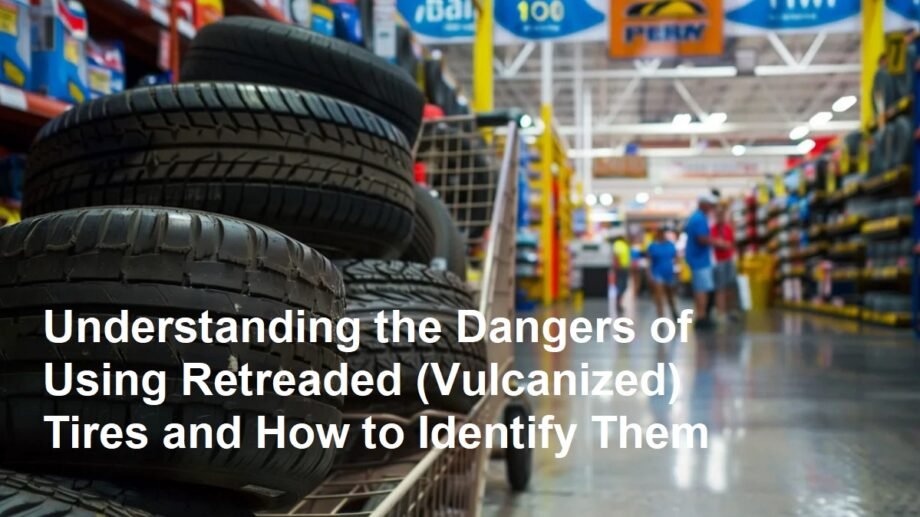Introduction
Retreaded tires, also known as vulcanized tires, are often seen as a cost-saving alternative to new tires. However, using these tires comes with potential dangers that car owners should be aware of to ensure their safety on the road.
Dangers of Using Retreaded (Vulcanized) Tires
1. Reduced Tire Performance and Safety
Retreaded tires often lack the same structural integrity and performance as new tires because the original tire carcass is reused.
- They may have weaker sidewalls or tread bonding, increasing the risk of blowouts.
- Reduced grip and traction can affect handling and braking, especially on wet or slippery surfaces.
- The likelihood of tread separation is higher, potentially causing accidents.
2. Shorter Lifespan and Durability
Although cheaper, vulcanized tires generally don’t last as long as new ones.
- The retread process cannot fully restore the tire to its original condition.
- Wear resistance is lower, meaning frequent replacements may be necessary.
- Frequent tire failure increases the overall safety risk.
3. Higher Risk of Blowouts and Accidents
Due to compromised structural integrity, retreaded tires have a higher risk of sudden failure.
- Blowouts at high speeds can lead to loss of vehicle control.
- Uneven tread wear may create vibrations affecting vehicle stability.
- Increased likelihood of tire failure is particularly concerning for long-distance or highway driving.
4. Poor Resistance to Extreme Conditions
Retreaded tires may not perform well under extreme weather or road conditions.
- They may deteriorate faster when exposed to high heat, intense sunlight, or rough roads.
- The rubber compound used in retreading might not offer the best grip in rain or snow.
- This can compromise safety during adverse weather conditions.
5. Legal and Warranty Issues
In some regions, using retreaded tires may affect insurance claims or warranty coverage.
- Some manufacturers void warranties if retreaded tires are used.
- Certain countries or states have strict regulations about retreaded tire use.
- Non-compliance could lead to fines or insurance complications in accidents.
How to Identify Retreaded (Vulcanized) Tires
1. Look for Markings and Labels
Retreaded tires have specific markings on the sidewall indicating they are vulcanized.
- Common labels include “Retread,” “Tread Rebuilt,” or “Vulcanized.”
- The DOT code might also include clues about retreading.
- Absence of these labels may indicate a new tire, but not always.
2. Inspect the Tread Pattern and Surface
Retreaded tires often show subtle differences in tread design compared to new tires.
- Tread surface may appear uneven or show signs of repairs.
- Some retreads have a visible seam where new tread was applied.
- Differences in rubber texture or coloration can be a clue.
3. Check for Manufacturer Information
New tires usually have clear manufacturer details embossed on the sidewall, whereas retreads might lack them.
- Look for brand names, tire model, and production date.
- Retreaded tires sometimes have minimal or altered branding.
4. Examine the Bead and Sidewall Area
The bead area (where tire contacts the rim) and sidewalls may reveal signs of vulcanization.
- Look for irregularities, patched areas, or unusual markings.
- Sidewalls on retreaded tires may appear less smooth or have visible repairs.
5. Consult a Professional
If unsure, a trusted tire technician can inspect tires and confirm if they are retreaded.
Summary Table: Dangers and Identification of Retreaded Tires
| Aspect | Details | Tips/Signs to Identify |
| Reduced Performance | Less grip, weaker structure, tread separation risk | Check for uneven tread, poor handling |
| Shorter Lifespan | Wears out faster | Frequent tire replacement needed |
| Blowout Risk | Higher chance of sudden failure | Inspect for tread separation and vibrations |
| Poor Extreme Condition Resistance | Deteriorates under heat, rain, rough roads | Watch for cracks, discoloration |
| Legal/Warranty Concerns | Possible insurance or warranty issues | Verify regulations, check warranty terms |
| Markings/Labels | Sidewall shows “Retread” or “Vulcanized” | Look closely at sidewall details |
| Tread Pattern & Surface | Visible seams or texture differences | Compare with new tire tread patterns |
| Manufacturer Info | Lacking or altered branding | Inspect sidewall for missing/altered details |
| Bead & Sidewall Area | Irregularities or repairs visible | Look for patches or rough areas |
Conclusion
While retreaded or vulcanized tires may offer a budget-friendly option, they come with notable risks including reduced performance, higher blowout potential, and shorter lifespan. Recognizing the signs of retreaded tires and understanding their dangers can help drivers make safer choices. Regular tire inspections and opting for new tires when possible ensure the best safety and performance on the road.









